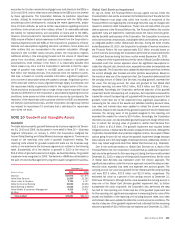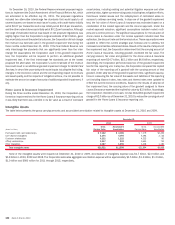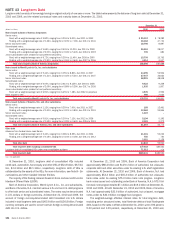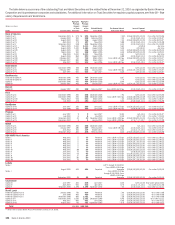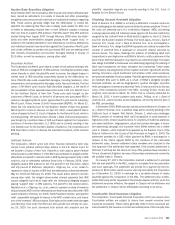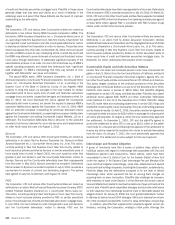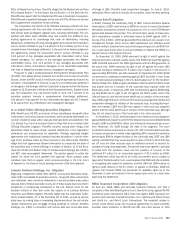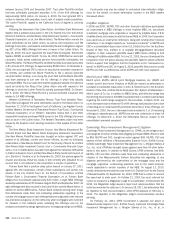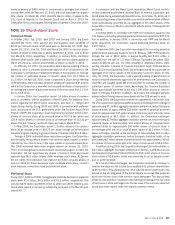Bank of America 2010 Annual Report Download - page 202
Download and view the complete annual report
Please find page 202 of the 2010 Bank of America annual report below. You can navigate through the pages in the report by either clicking on the pages listed below, or by using the keyword search tool below to find specific information within the annual report.Payment Protection Insurance Claims Matter
In the U.K., the Corporation sells payment protection insurance (PPI) through
its Global Card Services business to credit card customers and has previously
sold this insurance to consumer loan customers. PPI covers a consumer’s
loan or debt repayment if certain events occur such as loss of job or illness. In
response to an elevated level of customer complaints of misleading sales
tactics across the industry, heightened media coverage and pressure from
consumer advocacy groups, the U.K. Financial Services Authority (FSA) has
investigated and raised concerns about the way some companies have
handled complaints relating to the sale of these insurance policies. In August
2010, the FSA issued a policy statement on the assessment and remediation
of PPI claims which is applicable to the Corporation’s U.K. consumer busi-
nesses and is intended to address concerns among consumers and regula-
tors regarding the handling of PPI complaints across the industry. The policy
statement sets standards for the sale of PPI that apply to current and prior
sales, and in the event a company does not or did not comply with the
standards, it is alleged that the insurance was incorrectly sold, giving the
customer rights to remedies. The FSA gave companies until December 1,
2010 to comply with the new regulations, but the judicial review to assess
compliance is still underway. Given the new regulatory guidance, as of De-
cember 31, 2010, the Corporation has a liability of $630 million based on its
current claims history and an estimate of future claims that have yet to be
asserted against the Corporation. The liability is included in accrued expenses
and other liabilities and the related expense is included in insurance income.
The policy statement also requires companies to review their sales practices
and to proactively remediate non-complaining customers if evidence of a
systematic breach of the newly articulated sales standards is discovered,
which could include refunding premiums paid. Subject to the outcome of the
Corporation’s review and the new regulatory guidance, it is possible that an
additional liability may be required. Industry groups have challenged the policy
statement through a judicial review process. The judicial review is not ex-
pected to be completed until the end of the first quarter of 2011. Therefore,
the Corporation is unable to reasonably estimate the total amount of addi-
tional possible loss or a range of loss as of December 31, 2010.
Litigation and Regulatory Matters
In the ordinary course of business, the Corporation and its subsidiaries are
routinely defendants in or parties to many pending and threatened legal
actions and proceedings, including actions brought on behalf of various
classes of claimants. These actions and proceedings are generally based
on alleged violations of consumer protection, securities, environmental,
banking, employment and other laws. In some of these actions and proceed-
ings, claims for substantial monetary damages are asserted against the
Corporation and its subsidiaries.
In the ordinary course of business, the Corporation and its subsidiaries
are also subject to regulatory examinations, information gathering requests,
inquiries and investigations. Certain subsidiaries of the Corporation are
registered broker/dealers or investment advisors and are subject to regula-
tion by the SEC, the Financial Industry Regulatory Authority (FINRA), the New
York Stock Exchange, the FSA and other domestic, international and state
securities regulators. In connection with formal and informal inquiries by
those agencies, such subsidiaries receive numerous requests, subpoenas
and orders for documents, testimony and information in connection with
various aspects of their regulated activities.
In view of the inherent difficulty of predicting the outcome of such litigation
and regulatory matters, particularly where the claimants seek very large or
indeterminate damages or where the matters present novel legal theories or
involve a large number of parties, the Corporation generally cannot predict
what the eventual outcome of the pending matters will be, what the timing of
the ultimate resolution of these matters will be, or what the eventual loss,
fines or penalties related to each pending matter may be.
In accordance with applicable accounting guidance, the Corporation es-
tablishes an accrued liability for litigation and regulatory matters when those
matters present loss contingencies that are both probable and estimable. In
such cases, there may be an exposure to loss in excess of any amounts
accrued. When a loss contingency is not both probable and estimable, the
Corporation does not establish an accrued liability. As a litigation or regulatory
matter develops, the Corporation, in conjunction with any outside counsel
handling the matter, evaluates on an ongoing basis whether such matter
presents a loss contingency that is probable and estimable. If, at the time of
evaluation, the loss contingency related to a litigation or regulatory matter is
not both probable and estimable, the matter will continue to be monitored for
further developments that would make such loss contingency both probable
and estimable. Once the loss contingency related to a litigation or regulatory
matter is deemed to be both probable and estimable, the Corporation will
establish an accrued liability with respect to such loss contingency and record
a corresponding amount of litigation-related expense. The Corporation con-
tinues to monitor the matter for further developments that could affect the
amount of the accrued liability that has been previously established. Excluding
fees paid to external legal service providers, litigation-related expense of
$2.6 billion was recognized in 2010 compared to $1.0 billion for 2009.
For a limited number of the matters disclosed in this Note for which a loss
is probable or reasonably possible in future periods, whether in excess of a
related accrued liability or where there is no accrued liability, the Corporation
is able to estimate a range of possible loss. In determining whether it is
possible to provide an estimate of loss or range of possible loss, the Cor-
poration reviews and evaluates its material litigation and regulatory matters
on an ongoing basis, in conjunction with any outside counsel handling the
matter, in light of potentially relevant factual and legal developments. These
may include information learned through the discovery process, rulings on
dispositive motions, settlement discussions, and other rulings by courts,
arbitrators or others. In cases in which the Corporation possesses sufficient
appropriate information to develop an estimate of loss or range of possible
loss, that estimate is aggregated and disclosed below. There may be other
disclosed matters for which a loss is probable or reasonably possible but
such an estimate may not be possible. For those matters where an estimate
is possible, management currently estimates the aggregate range of possible
loss is $145 million to $1.5 billion in excess of the accrued liability (if any)
related to those matters. This estimated range of possible loss is based upon
currently available information and is subject to significant judgment and a
variety of assumptions, and known and unknown uncertainties. The matters
underlying the estimated range will change from time to time, and actual
results may vary significantly from the current estimate. Those matters for
which an estimate is not possible are not included within this estimated range.
Therefore, this estimated range of possible loss represents what the Corpo-
ration believes to be an estimate of possible loss only for certain matters
meeting these criteria. It does not represent the Corporation’s maximum loss
exposure. Information is provided below regarding the nature of all of these
contingencies and, where specified, the amount of the claim associated with
these loss contingencies. Based on current knowledge, management does
not believe that loss contingencies arising from pending matters, including the
matters described herein, will have a material adverse effect on the consol-
idated financial position or liquidity of the Corporation. However, in light of the
inherent uncertainties involved in these matters, some of which are beyond
the Corporation’s control, and the very large or indeterminate damages
sought in some of these matters, an adverse outcome in one or more of
these matters could be material to the Corporation’s results of operations or
cash flows for any particular reporting period.
200 Bank of America 2010



